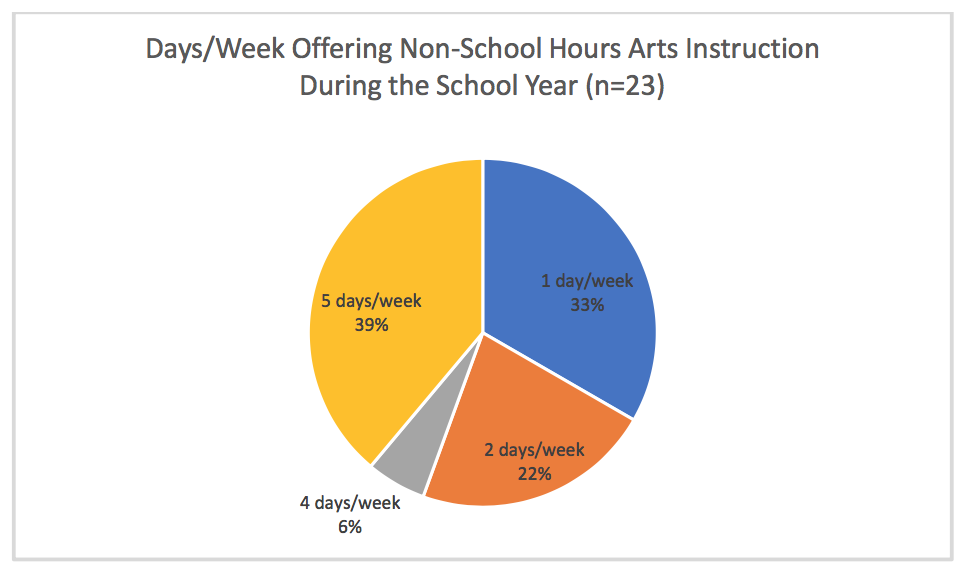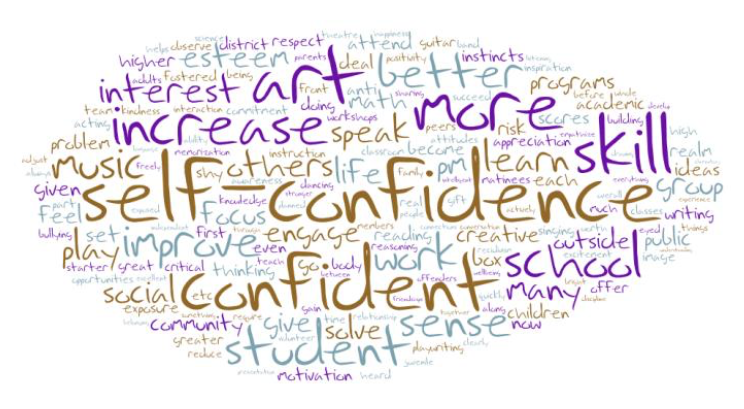Appendix D: Non-Profit Organization Survey Results
As part of the assessment of current arts engagement and arts exposure opportunities for K-8 grade students in the Sacramento Region, local arts organizations were surveyed. These organizations provide arts instruction or exposure opportunities. The arts organizations voluntarily completed this survey, self-reporting the type and quantity of arts instructions they provide to local school districts both during and beyond the school day.
Feedback was solicited from organizations that provide services in the following five districts: Sacramento City, Elk Grove, Twin Rivers, Robla, and Natomas. Organizations taking this survey were primarily nonprofits. In total, there was a 23% survey completion rate, representing 46 responses.
Key Findings:
-
Types of Art Provided: a. Instruction: Visual, Literary b. Exposure: Music, Theatre
-
Districts Served: a. Majority work with SCUSD and EGUSD. The district that was served the least was Robla
-
Program Longevity: a. Instruction: 3-5 years (during school) and 10+ years (after school) b. Exposure: 10+ years (both during and after)
-
Number of students served during school day (over the course of one year) a. Instruction: 2,035 b. Exposure: 8,111
-
Very few organizations have found success carving out a space during the school day to provide programming.
-
The majority of organizations surveyed do not have an in-school presence.
-
Surveyed organizations ask for stronger communication between school districts and arts organizations and district-wide points of contact for arts collaboration.
-
Many positive benefits of arts education were identified by organizations surveyed, including both academic and soft skill acquisition
-
Lack of funding is the most often reported barrier to providing more arts education in schools
-
Improved / Clear communication channels with school or district staff to local arts organizations would likely increase the availability of arts opportunities for students
Detailed Survey Data and Analysis
Types of art, districts served, program longevity, # of students served:
A total of 2,035 students are being provided arts instruction by an outside arts organization during the school day (of 30 organizations responding). Only 7 organizations responded that they are serving students in the school districts listed in the survey. All respondents stated they are serving SCUSD and 4 stated they are serving EGUSD, the two school districts receiving the most arts education support from outside organizations. Visual arts and literary arts were the top two types of arts instruction being provided by the 8 organizations that responded to the question. Of the 7 organizations that responded, the majority stated they have been providing arts instruction to the five school districts for 3-5 years.
Of 20 responding organizations, half reported that they have been providing non-school hours arts instruction for over 10 years.
A total of 8,111 students are provided arts exposure experiences per week (15 responding organizations). It should also be noted that several respondents stated that they do not do weekly exposure. Experiences are periodic in nature happening once a year, once a quarter, or whenever they are contacted by schools. The number one arts exposure experience based on the 15 organizations that responded is music (73%), followed by theater (67%) and dance (47%). The average number of schools that arts organizations work with to provide arts exposure experiences during school hours is 49 (15 responses). Of the 15 respondents, 93% are working with SCUSD and over half of them are in all other school districts listed, except for Robla (33%). Of the 15 respondents, 1/3 have been providing in-school arts exposure experiences for over 10 years.
The average number of schools that organizations work with to provide arts exposure experiences during non-school hours is 5. Of the 17 respondents, the majority (82%) are working with SCUSD, with EGUSD coming at number two with 65%. The lowest number or respondents (23%) reported that they work with Robla. Of the 17 respondents, nearly half (47%) reported that they have been providing non-school arts exposure experiences for over 10 years.
Arts Instruction During the School day:
Of the 46 organizations that participated in the survey, 16 responded that they offer some form of in-school art programming. Below are highlights from the organizations that have found success working in-schools providing arts programs.
Note: Survey results are not inclusive of all nonprofit-organizations working in arts education – only 46 of 200 organizations responded therefore it is difficult to get a full picture of the programs that non-profit organizations are implementing.
Activity
| Organization | Days/week in Schools | Avg. # of Students Reached |
|---|---|---|
| B Street Theater | 5 | 60/day |
| Crocker Art Museum | 5 | 33,364/yr |
| Davis Arts Center | 5 | 20/day |
| Fairy Tale Town | 3 | 300/day |
| Roseville Theater Arts Company | 1 | 27/day |
| Sacramento Children’s Museum | 2 | 20/day |
| Sacramento Metropolitan Arts Commission | 3 | 100-300/day |
| Sojourner Truth Museum | 2 | 40/day |
School Districts
| Organization | Elk Grove | Natomas | Robla | Sacramento City | Twin Rivers |
|---|---|---|---|---|---|
| B Street Theater | x | x | x | x | x |
| Crocker Art Museum | x | x | x | x | x |
| Davis Arts Center | x | x | |||
| Fairy Tale Town | x | x | x | x | x |
| Roseville Theater Arts Company | x | x | x | ||
| Sacramento Children’s Museum | x | x | x | ||
| Sacramento Metropolitan Arts Commission | x | x | x | x | |
| Sojourner Truth Museum | x |
Art Themes Covered
| Organization | Dance | Literary | Music | Theatre | Visual | No Response |
|---|---|---|---|---|---|---|
| B Street Theater | x | x | ||||
| Crocker Art Museum | x | x | x | x | ||
| Davis Arts Center | x | |||||
| Fairy Tale Town | x | |||||
| Roseville Theater Arts Company | x | x | ||||
| Sacramento Children’s Museum | x | x | ||||
| Sacramento Metropolitan Arts Commission | x | x | x | x | x | |
| Sojourner Truth Museum | x |
Arts Instruction Beyond the School day:
Collectively, 23 survey respondents are serving 21,570 students annually (though unknown what percent of these students are cross enrolled in programs). The majority of arts nonprofits offering non-school hours programming during the school year either offer it one day per week, or five days per week.

Reported Benefits of offering arts education within the school day:
Positive changes, as reported, included reading and language skills, critical thinking skills, social skills, motivation to learn, and positive school environment. Additionally, respondents added greater self-esteem and self-confidence, which was a prominent answer within the more general question below regarding positive change, as observed by students who have participated in art education classes. (8 respondents).

Reported Barriers of offering arts education within the school day:
Of 29 respondents, 17 of them ranked “Lack of Funding” as the largest barrier to increasing arts education services during the school day. Coordination with schools and school districts (6) and lack of capacity (6) were the next most reported answers.
When asked what arts organizations would do if they could “wave a magic wand,” to improve arts education and arts education opportunities for students, the ideas varied from specific ideas such as arts in residency in schools to building collaborative partnerships between the schools, teachers, and arts organizations. Arts organizations also desire to have advocates in the schools to share information about the programs that are offered outside of the school system. The continued need for funding to support arts programs and simplifying the bureaucracy of how the arts organizations interact with the schools could enable arts education.